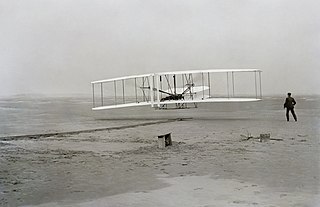
The Kyūshū J7W Shinden is a World War II Japanese propeller-driven prototype fighter plane with wings at the rear of the fuselage, a nose-mounted canard, and a pusher engine.

The Curtiss-Wright XP-55 Ascender (company designation CW-24 is a 1940s United States prototype fighter aircraft built by Curtiss-Wright. Along with the Vultee XP-54 and Northrop XP-56, it resulted from United States Army Air Corps proposal R-40C issued on 27 November 1939 for aircraft with improved performance, armament, and pilot visibility over existing fighters; it specifically allowed for unconventional aircraft designs. An unusual design for its time, it had a canard configuration with a rear-mounted engine, and two vertical tails at end of swept wings. Because of its pusher design, it was satirically referred to as the "Ass-ender". Like the XP-54, the Ascender was designed for the 1,800 hp Pratt & Whitney X-1800 24-Cylinder H-engine, but was redesigned after that engine project was canceled. It was also the first Curtiss fighter aircraft to use tricycle landing gear.

In aeronautical and naval engineering, pusher configuration is the term used to describe a drivetrain of air- or watercraft with its propulsion device(s) after its engine(s). This is in contrast to the more conventional tractor configuration, which places them in front.

The Rutan Quickie is a lightweight single-seat taildragger aircraft of composite construction, configured with tandem wings.
The Latécoère 570 was a twin-engined medium bomber designed to a 1934 specification. It did not fly until 1939, by which time competitor aircraft had gone into service.
The Mansyū Ki-98,, was a Japanese ground-attack aircraft proposed by Mansyū during World War II for use by the Imperial Japanese Army Air Force. The still unassembled components of the first prototype were deliberately destroyed before Japan surrendered.
The Latécoère 225 was an unusual single seat canard microlight amphibian, with a swept wing, and of pusher configuration. It first flew in 1984 but was not put into production.

The Ion Aircraft Ion is a two-seat, twin boom, pusher configuration light aircraft based on the DreamWings Valkyrie. It was still in development in 2010 but is intended either for homebuilding from kits or flyaway production, with versions meeting US and European rules.

The Savoia-Marchetti SM.80 is a two-seat monoplane amphibian tourer, with a single, tractor engine mounted above the wing, designed in Italy in the early 1930s. The SM.80bis is a four-seat variant, powered by two pusher engines.

The Siemens-Schuckert DDr.I was a World War I German twin engine, push-pull configuration triplane fighter aircraft. Only one was built, crashing on its first flight.
The Farner HF Colibri 1 SL was an unusual canard motor glider with a unique control system, designed and built in Switzerland in the late 1970s. Only one was constructed; much modified during the 1980s, it was still flying in 1990.

The Nieuport-Delage NiD 48 was a French single-engine parasol wing light fighter aircraft, designed and built in the 1920s. Its performance was not markedly better than that of the much heavier Nieuport-Delage NiD 62 then going into production, so only two were flown.

The Loire-Nieuport 161 was a single-seat, single-engine, all-metal, low-wing monoplane fighter designed and built in France in 1935 to compete for a government contract. Accidents delayed its development and only three prototypes were completed.
The Weymann W-1 was a French single seat biplane fighter aircraft, built during World War I. It had a most unusual layout, with an engine buried in the fuselage driving a pusher configuration propeller behind a cruciform tail. It was not successful and soon abandoned.

The Hanriot H.110 was an unusual pusher configuration, twin boom, single seat fighter aircraft built in France in the early 1930s. It proved to be slower and less manoeuvrable than its contemporaries and failed to reach production, even as the Hanriot H.115 after receiving a more powerful engine and cannon armament.

The Schütte-Lanz G.I was a large, twin engine, pusher configuration, experimental biplane built in Germany early in World War I. Only one was completed.
The Aviator Shershen' is a Russian two seat biplane, sold in kit form. It first flew in 2005 and several variants have been produced, with a choice of engines.
The Bonomi BS.22 Alzavola was a training motor glider, intended to acquaint capable glider pilots with the characteristics of powered aircraft. The sole example was designed and built in Italy in the mid-1930s.

The de Bruyère C 1 was a prototype French single seat pusher canard Fighter of unusual design produced during World War I. The sole example built crashed on its first flight, and development terminated.

The De Schelde S.21 was a proposed Dutch fighter of the late 1930s and early 1940s. It was a single-seat, single-engined, pusher monoplane. A single prototype was under construction in 1940, but work was abandoned due to the German invasion.














